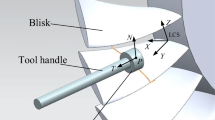Abstract
A novel collision detection algorithm of abrasive belt grinding blade integrated disk (blisk) based on improved octree segmentation is proposed, to improve the accuracy and efficiency of collision detection while ensuring dimensional accuracy and surface quality. The traditional collision detection algorithm model is described in detail, among them, the collision detection model of the abrasive belt is obtained by establishing its Oriented Bounding Box (OBB), and the collision detection model of the blisk is established by the octree segmentation. Then, an improved octree segmentation based on k-means clustering method can be presented by analyzing the important factors that affect the collision detection; on this basis, an algorithm of collision detection for abrasive belt grinding blisk is given. Finally, algorithm verification and experimental verification are carried out based on a blisk with certain type, respectively. Compared with the traditional collision detection algorithm, the results with algorithm verification illustrate that the accuracy and efficiency of algorithm in this paper have promoted by 45% and 18.60%, respectively; and the results with experimental verification demonstrate that the accuracy and efficiency of algorithm in this paper have improved by 45% and 18.44%, respectively.



















Similar content being viewed by others
Availability of data and material
All data generated or analyzed during this study are included in this manuscript.
Code availability
Our research is supported by code. If you want to get the code, please contact the corresponding author of this paper.
References
Huang Z, Wei PX, Li C, Wang HY, Wang JY (2020) Aero-engine blade profile reconstruction based on adaptive step size bat algorithm and visualization of machining error. Proc Inst Mech Eng C J Mech Eng Sci 234:49–65
Zou L, Huang Y, Zhang GJ, Cui XP (2019) Feasibility study of a flexible grinding method for precision machining of the TiAl-based alloy. Mater Manuf Process 34:1160–1168
Xuan W, Cai YL (2017) The tool path planning of composed surface of big-twisted blisk. Procedia Eng 174:392–401
Shigematsu T, Koike R, Kakinuma Y, Aoyama T, Ohnishi K (2016) Sensorless tool collision detection for multi-axis machine tools by integration of disturbance information. Procedia CIRP 57:658–663
Xu XH, Zhu DH, Zhang HY, Yan SJ, Ding H (2019) Application of novel force control strategies to enhance robotic abrasive belt grinding quality of aero-engine blades. Chin J Aeronaut 32:2368–2382
Zhang ZY, Huo YX, Guo DM (2013) A model for nanogrinding based on direct evidence of ground chips of silicon wafers. Sci China Technol Sci 56:2099–2108
Zhang ZY, Huang SL, Wang SC, Wang B, Bai Q, Zhang B, Kang RK, Guo DM (2017) A novel approach of high-performance grinding using developed diamond wheels. Int J Adv Manuf Technol 91:3315–3326
Zou L, Liu X, Huang Y, Fei Y (2019) A numerical approach to predict the machined surface topography of abrasive belt flexible grinding. Int J Adv Manuf Technol 104:2961–2970
Ilies HT (2009) Continuous collision and interference detection for 3D geometric models. J Comput Inf Sci Eng 9:1–7
Zhang T, Su JW (2018) Collision-free planning algorithm of motion path for the robot belt grinding system. Int J Adv Rob Syst 15:1–13
Tang YH, Hou J, Wu TT, Gong S, Zhang J, Zhong LT (2018) Hybrid collision detection algorithm based on particle conversion and bounding box. Harbin Gongcheng Daxue Xuebao/J Harbin Eng Univ 39:1695–1701
Zou YN, Liu PX, Yang CS, Li CQ, Cheng QQ (2017) Collision detection for virtual environment using particle swarm optimization with adaptive cauchy mutation. Cluster Comput 20:1765–1774
Tang TD, Bohez ELJ (2015) A new collision avoidance strategy and its integration with collision detection for five-axis NC machining. Int J Adv Manuf Technol 81:1247–1258
Hegedűs G (2016) Newton’s method based collision avoidance in a cad environment on ball nut grinding. Int J Adv Manuf Technol 84:1219–1228
Huang Y, Xiao GJ, Zou L (2019) Current situation and development trend of robot precise belt grinding for aero-engine blade. Acta Aeronaut Astronaut Sin 40:1–20
Lin XB, Lin FN (2016) Hybrid hierarchical collision detection based on data reuse. Telkomnika Telecommun Comput Electron Control 14:1077–1082
Vo AV, Truong-Hong L, Laefer DF, Bertolotto M (2015) Octree-based region growing for point cloud segmentation. ISPRS J Photogramm Remote Sens 104:88–100
Abbas SA, Aslam A, Rehman AU, Abbasi WA, Arif S, Kazmi SZH (2020) K-Means and K-Medoids: cluster analysis on birth data collected in City Muzaffarabad, Kashmir. IEEE Access, pp. 151847–151855
Abdelrahman TS (2020) Cooperative software-hardware acceleration of K-means on a tightly coupled CPU-FPGA system. ACM Trans Archit Code Optim 17:1–24
Tang M, Manocha D, Yoon SE et al (2011) VolCCD: Fast continuous collision culling between deforming volume meshes. ACM Trans Graph 30:1–15
El-Sousy FFM (2016) Intelligent mixed H2/H∞ adaptive tracking control system design using self-organizing recurrent fuzzy-wavelet-neural-network for uncertain two-axis motion control system. Appl Soft Comput 41:22–50
Huang Z, Wei PX, Wan CB, Wang HY, Wu XG, Wang JY (2020) Collision detection method of blisk grinding and polishing. CIMS Comput Integr Manuf Syst 26:3350–3358
Huang Z, Wu X, Liu HT, Wan YJ, Zheng X, Chen X (2020) Robot polishing technology of spherical grinding head with revolution and rotation motion based on constant pressure control (in Chinese). China Mech Eng 31:519–526
Funding
The Fundamental Research Funded by Sichuan Science and Technology Plan (grant number: 2020YFG0407/2020JDRC0173).
Author information
Authors and Affiliations
Corresponding author
Ethics declarations
Ethics approval and consent to participate
Yes, we agreed to participate.
Consent for publication
Not applicable.
Conflict of interest
The authors declare no competing interests.
Additional information
Publisher's note
Springer Nature remains neutral with regard to jurisdictional claims in published maps and institutional affiliations.
Rights and permissions
About this article
Cite this article
Huang, Z., Yang, X., Min, J. et al. Collision detection algorithm on abrasive belt grinding blisk based on improved octree segmentation. Int J Adv Manuf Technol 118, 4105–4121 (2022). https://doi.org/10.1007/s00170-021-08213-w
Received:
Accepted:
Published:
Issue Date:
DOI: https://doi.org/10.1007/s00170-021-08213-w




